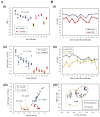Recoverability of Microcystis aeruginosa and Pseudanabaena foetida Exposed to a Year-Long Dark Treatment
- PMID: 38004771
- PMCID: PMC10672943
- DOI: 10.3390/microorganisms11112760
Recoverability of Microcystis aeruginosa and Pseudanabaena foetida Exposed to a Year-Long Dark Treatment
Abstract
Cyanobacteria are a significant primary producer and pioneer species that play a vital role in ecological reconstruction, especially in aquatic environments. Cyanobacteria have excellent recovery capacity from significant stress exposure and are thus suggested as bioreserves, even for space colonization programs. Few studies have been conducted on the recovery capacity after experiencing stress. Long-duration darkness or insufficient light is stressful for photosynthetic species, including cyanobacteria, and can cause chlorosis. Cyanobacterial recovery after extensive exposure to darkness has not yet been studied. In this experiment, Microcystis aeruginosa and Pseudanabaena foetida were subjected to a year-long darkness treatment, and the change in recovery capacity was measured in monthly samples. Cyanobacterial growth, chlorophyll-a concentration, oxidative stress, and photosynthetic capacity were evaluated. It was found that the rapid recovery capacity of the two species remained even after one year of darkness treatment. However, the H2O2 content of recovered samples of both M. aeruginosa and P. foetida experienced significant changes at six-seven months, although the photosynthetic capacity of both cyanobacteria species was maintained within the healthy range. The chlorophyll-a and carotenoid content of the recovered samples also changed with increasing darkness. The results showed that long-term dark treatment had time-dependent effects but different effects on M. aeruginosa and P. foetida. However, both cyanobacteria species can recover rapidly after one year of dark treatment.
Keywords: bioreserve; cyanobacterial growth; extensive darkness; photosynthetic ability; stress recovery.
Conflict of interest statement
The authors declare no conflict of interest.
Figures




Similar articles
-
Interspecific competition between Microcystis aeruginosa and Pseudanadaena and their production of T&O compounds.Chemosphere. 2020 Aug;252:126509. doi: 10.1016/j.chemosphere.2020.126509. Epub 2020 Mar 16. Chemosphere. 2020. PMID: 32224357
-
Long-term acclimation to warming improves the adaptive ability of Microcystis aeruginosa to high temperature: Based on growth, photosynthetic activity, and microcystin production.Environ Pollut. 2023 Dec 1;338:122727. doi: 10.1016/j.envpol.2023.122727. Epub 2023 Oct 12. Environ Pollut. 2023. PMID: 37838315
-
Flow velocity and light intensity combination is important for Microcystis aeruginosa physical suppression.Water Environ Res. 2024 Feb;96(2):e10991. doi: 10.1002/wer.10991. Water Environ Res. 2024. PMID: 38291777
-
Impacts of antibiotic contaminants on Microcystis aeruginosa during potassium permanganate treatment.Harmful Algae. 2020 Feb;92:101741. doi: 10.1016/j.hal.2020.101741. Epub 2020 Jan 27. Harmful Algae. 2020. PMID: 32113608
-
Photosynthetic adaptation to light availability shapes the ecological success of bloom-forming cyanobacterium Pseudanabaena to iron limitation.J Phycol. 2020 Dec;56(6):1457-1467. doi: 10.1111/jpy.13040. Epub 2020 Aug 14. J Phycol. 2020. PMID: 32557638
References
-
- Kulasooriya S.A. Cyanobacteria: Pioneers of Planet Earth. Ceylon J. Sci. 2011;40:71–88. doi: 10.4038/cjsbs.v40i2.3925. - DOI
-
- Kvíderová J., Elster J., Komárek J. Chapter 14—Ecophysiology of Cyanobacteria in the Polar Regions. In: Mishra A.K., Tiwari D.N., Rai A.N., editors. Cyanobacteria. Academic Press; Cambridge, MA, USA: 2019. pp. 277–302. - DOI
Grants and funding
LinkOut - more resources
Full Text Sources

